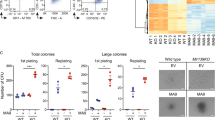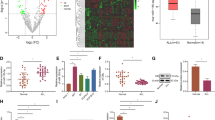Abstract
MicroRNAs (miRNAs) regulate the expression of multiple proteins in a dose-dependent manner. We hypothesized that increased expression of miRNAs encoded on chromosome 21 (chr 21) contribute to the leukemogenic function of trisomy 21. The levels of chr 21 miRNAs were quantified by qRT–PCR in four types of childhood acute lymphoblastic leukemia (ALL) characterized by either numerical (trisomy or tetrasomy) or structural abnormalities of chr 21. Suprisingly, high expression of the hsa-mir-125b-2 cluster, consisting of three miRNAs, was identified in leukemias with the structural ETV6/RUNX1 abnormality and not in ALLs with trisomy 21. Manipulation of ETV6/RUNX1 expression and chromatin immunoprecipitation studies showed that the high expression of the miRNA cluster is an event independent of the ETV6/RUNX1 fusion protein. Overexpression of hsa-mir-125b-2 conferred a survival advantage to Ba/F3 cells after IL-3 withdrawal or a broad spectrum of apoptotic stimuli through inhibition of caspase 3 activation. Conversely, knockdown of the endogenous miR-125b in the ETV6/RUNX1 leukemia cell line REH increased apoptosis after Doxorubicin and Staurosporine treatments. P53 protein levels were not altered by miR-125b. Together, these results suggest that the expression of hsa-mir-125b-2 in ETV6/RUNX1 ALL provides survival advantage to growth inhibitory signals in a p53-independent manner.
This is a preview of subscription content, access via your institution
Access options
Subscribe to this journal
Receive 12 print issues and online access
$259.00 per year
only $21.58 per issue
Buy this article
- Purchase on Springer Link
- Instant access to full article PDF
Prices may be subject to local taxes which are calculated during checkout






Similar content being viewed by others
References
Heerema NA, Sather HN, Sensel MG, Zhang T, Hutchinson RJ, Nachman JB et al. Prognostic impact of trisomies of chromosomes 10, 17, and 5 among children with acute lymphoblastic leukemia and high hyperdiploidy (>50 chromosomes). J Clin Oncol 2000; 18: 1876–1887.
Moorman AV, Richards SM, Martineau M, Cheung KL, Robinson HM, Jalali GR et al. Outcome heterogeneity in childhood high-hyperdiploid acute lymphoblastic leukemia. Blood 2003; 102: 2756–2762.
Hasle H . Pattern of malignant disorders in individuals with Down's syndrome. Lancet Oncol 2001; 2: 429–436.
Strefford JC, van Delft FW, Robinson HM, Worley H, Yiannikouris O, Selzer R et al. Complex genomic alterations and gene expression in acute lymphoblastic leukemia with intrachromosomal amplification of chromosome 21. Proc Natl Acad Sci USA 2006; 103: 8167–8172.
Pui CH, Relling MV, Downing JR . Acute lymphoblastic leukemia. N Engl J Med 2004; 350: 1535–1548.
Romana SP, Mauchauffe M, Le Coniat M, Chumakov I, Le Paslier D, Berger R et al. The t(12;21) of acute lymphoblastic leukemia results in a tel-AML1 gene fusion. Blood 1995; 85: 3662–3670.
Greaves MF, Wiemels J . Origins of chromosome translocations in childhood leukaemia. Nat Rev Cancer 2003; 3: 639–649.
Hong D, Gupta R, Ancliff P, Atzberger A, Brown J, Soneji S et al. Initiating and cancer-propagating cells in TEL-AML1-associated childhood leukemia. Science 2008; 319: 336–339.
Ambros V . The functions of animal microRNAs. Nature 2004; 431: 350–355.
Lee YS, Kim HK, Chung S, Kim KS, Dutta A . Depletion of human micro-RNA miR-125b reveals that it is critical for the proliferation of differentiated cells but not for the down-regulation of putative targets during differentiation. J Biol Chem 2005; 280: 16635–16641.
Iorio MV, Ferracin M, Liu CG, Veronese A, Spizzo R, Sabbioni S et al. MicroRNA gene expression deregulation in human breast cancer. Cancer Res 2005; 65: 7065–7070.
Xia HF, He TZ, Liu CM, Cui Y, Song PP, Jin XH et al. MiR-125b expression affects the proliferation and apoptosis of human glioma cells by targeting Bmf. Cell Physiol Biochem 2009; 23: 347–358.
Sonoki T, Iwanaga E, Mitsuya H, Asou N . Insertion of microRNA-125b-1, a human homologue of lin-4, into a rearranged immunoglobulin heavy chain gene locus in a patient with precursor B-cell acute lymphoblastic leukemia. Leukemia 2005; 19: 2009–2010.
Bousquet M, Quelen C, Rosati R, Mansat-De Mas V, La Starza R, Bastard C et al. Myeloid cell differentiation arrest by miR-125b-1 in myelodysplastic syndrome and acute myeloid leukemia with the t(2;11)(p21;q23) translocation. J Exp Med 2008; 205: 2499–2506.
Le MT, Teh C, Shyh-Chang N, Xie H, Zhou B, Korzh V et al. MicroRNA-125b is a novel negative regulator of p53. Genes Dev 2009; 23: 862–876.
Metzler M, Wilda M, Busch K, Viehmann S, Borkhardt A . High expression of precursor microRNA-155/BIC RNA in children with Burkitt lymphoma. Genes Chromosomes Cancer 2004; 39: 167–169.
van den Berg A, Kroesen BJ, Kooistra K, de Jong D, Briggs J, Blokzijl T et al. High expression of B-cell receptor inducible gene BIC in all subtypes of Hodgkin lymphoma. Genes Chromosomes Cancer 2003; 37: 20–28.
Eis PS, Tam W, Sun L, Chadburn A, Li Z, Gomez MF et al. Accumulation of miR-155 and BIC RNA in human B cell lymphomas. Proc Natl Acad Sci USA 2005; 102: 3627–3632.
Kluiver J, Poppema S, de Jong D, Blokzijl T, Harms G, Jacobs S et al. BIC and miR-155 are highly expressed in Hodgkin, primary mediastinal and diffuse large B cell lymphomas. J Pathol 2005; 207: 243–249.
Costinean S, Zanesi N, Pekarsky Y, Tili E, Volinia S, Heerema N et al. Pre-B cell proliferation and lymphoblastic leukemia/high-grade lymphoma in E(mu)-miR155 transgenic mice. Proc Natl Acad Sci USA 2006; 103: 7024–7029.
Hebert SS, De Strooper B . Alterations of the microRNA network cause neurodegenerative disease. Trends Neurosci 2009; 32: 199–206.
Hertzberg L, Betts DR, Raimondi SC, Schafer BW, Notterman DA, Domany E et al. Prediction of chromosomal aneuploidy from gene expression data. Genes Chromosomes Cancer 2007; 46: 75–86.
Morrow M, Horton S, Kioussis D, Brady HJ, Williams O . TEL-AML1 promotes development of specific hematopoietic lineages consistent with pre-leukemic activity. Blood 2004; 103: 3890–3896.
Starkova J, Madzo J, Cario G, Kalina T, Ford A, Zaliova M et al. The identification of (ETV6)/RUNX1-regulated genes in lymphopoiesis using histone deacetylase inhibitors in ETV6/RUNX1-positive lymphoid leukemic cells. Clin Cancer Res 2007; 13: 1726–1735.
Frohling S, Scholl C, Levine RL, Loriaux M, Boggon TJ, Bernard OA et al. Identification of driver and passenger mutations of FLT3 by high-throughput DNA sequence analysis and functional assessment of candidate alleles. Cancer Cell 2007; 12: 501–513.
Scott GK, Goga A, Bhaumik D, Berger CE, Sullivan CS, Benz CC . Coordinate suppression of ERBB2 and ERBB3 by enforced expression of micro-RNA miR-125a or miR-125b. J Biol Chem 2007; 282: 1479–1486.
Shi XB, Xue L, Yang J, Ma AH, Zhao J, Xu M et al. An androgen-regulated miRNA suppresses Bak1 expression and induces androgen-independent growth of prostate cancer cells. Proc Natl Acad Sci USA 2007; 104: 19983–19988.
Klusmann J-H, Janikova K, Li Z, Orkin SH, Reinhardt D . Chromosome 21-encoded miR-125b and its role in the development of myeloid leukemia in children with Down's syndrome. ASH Annual Meeting Abstracts. 2007 November 16, 2007; 110: 716.
Kuhn DE, Nuovo GJ, Martin MM, Malana GE, Pleister AP, Jiang J et al. Human chromosome 21-derived miRNAs are overexpressed in down syndrome brains and hearts. Biochem Biophys Res Commun 2008; 370: 473–477.
Pui CH, Evans WE . Treatment of acute lymphoblastic leukemia. N Engl J Med 2006; 354: 166–178.
Ford AM, Palmi C, Bueno C, Hong D, Cardus P, Knight D et al. The TEL-AML1 leukemia fusion gene dysregulates the TGF-beta pathway in early B lineage progenitor cells. J Clin Invest 2009; 119: 826–836.
Sato T, Toki T, Kanezaki R, Xu G, Terui K, Kanegane H et al. Functional analysis of JAK3 mutations in transient myeloproliferative disorder and acute megakaryoblastic leukaemia accompanying Down syndrome. Br J Haematol 2008; 141: 681–688.
Huntly BJ, Shigematsu H, Deguchi K, Lee BH, Mizuno S, Duclos N et al. MOZ-TIF2, but not BCR-ABL, confers properties of leukemic stem cells to committed murine hematopoietic progenitors. Cancer Cell 2004; 6: 587–596.
Lacronique V, Boureux A, Monni R, Dumon S, Mauchauffe M, Mayeux P et al. Transforming properties of chimeric TEL-JAK proteins in Ba/F3 cells. Blood 2000; 95: 2076–2083.
McCubrey JA, Steelman LS, Abrams SL, Bertrand FE, Ludwig DE, Basecke J et al. Targeting survival cascades induced by activation of Ras/Raf/MEK/ERK, PI3K/PTEN/Akt/mTOR and Jak/STAT pathways for effective leukemia therapy. Leukemia 2008; 22: 708–722.
Ihle JN, Gilliland DG . Jak2: normal function and role in hematopoietic disorders. Curr Opin Genet Dev 2007; 17: 8–14.
Liu CB, Itoh T, Arai K, Watanabe S . Constitutive activation of JAK2 confers murine interleukin-3-independent survival and proliferation of BA/F3 cells. J Biol Chem 1999; 274: 6342–6349.
Bercovich D, Ganmore I, Scott LM, Wainreb G, Birger Y, Elimelech A et al. Mutations of JAK2 in acute lymphoblastic leukaemias associated with Down's syndrome. Lancet 2008; 372: 1484–1492.
Hon LS, Zhang Z . The roles of binding site arrangement and combinatorial targeting in microRNA repression of gene expression. Genome Biol 2007; 8: R166.
Baek D, Villen J, Shin C, Camargo FD, Gygi SP, Bartel DP . The impact of microRNAs on protein output. Nature 2008; 455: 64–71.
Selbach M, Schwanhausser B, Thierfelder N, Fang Z, Khanin R, Rajewsky N . Widespread changes in protein synthesis induced by microRNAs. Nature 2008; 455: 58–63.
Schindler JW, Van Buren D, Foudi A, Krejci O, Qin J, Orkin SH et al. TEL-AML1 corrupts hematopoietic stem cells to persist in the bone marrow and initiate leukemia. Cell stem cell 2009; 5: 43–53.
Acknowledgements
We thank J Crispino, G Lavi and Y Sidi for providing reagents; M Oren for fruitful discussions and provision of reagents; the Department of Pediatric Hematology and Oncology, Dr von Haunersches Kinderspital, Munich, Germany, for providing clinical samples; members of SI and AB laboratories for helpful discussions and, in particular, P Landgraf for his excellent criticism and advice. SI, NG, VB and AB designed experiments. NG, VB, YL, MM, OW, MZ, JT, LE, NS, AN designed and performed experiments. LH analyzed data. NG, VB, AB, SI wrote the paper. This work was supported by National Institute of Health R01 CA120772-01A2 (SI), German Israeli Foundation (SI & AB), The Wolfson Foundation (SI, NS), Israel Science Foundation Morasha (SI), Children with Leukaemia UK (SI), Leukemia Research Fund UK (OW and MM), Curtis Katz (SI), MSM0021620813 and MZO00064203 (JT and MZ), Jewish National Fund, UK (SI), Claudine Galli Foundation (NG), Converging Technologies program (LH), Elterninitiative Kinderkrebsklinik Duesseldorf (AB). The study has been performed as partial fulfillment of the requirements for PhD degree of Nir Gefen and Libi Hertzberg, Sackler School of Medicine, Tel Aviv University.
Author information
Authors and Affiliations
Corresponding author
Additional information
Supplementary Information accompanies the paper on the Leukemia website (http://www.nature.com/leu)
Supplementary information
Rights and permissions
About this article
Cite this article
Gefen, N., Binder, V., Zaliova, M. et al. Hsa-mir-125b-2 is highly expressed in childhood ETV6/RUNX1 (TEL/AML1) leukemias and confers survival advantage to growth inhibitory signals independent of p53. Leukemia 24, 89–96 (2010). https://doi.org/10.1038/leu.2009.208
Received:
Revised:
Accepted:
Published:
Issue Date:
DOI: https://doi.org/10.1038/leu.2009.208
Keywords
This article is cited by
-
Role of non-coding RNA networks in leukemia progression, metastasis and drug resistance
Molecular Cancer (2020)
-
Gain of chromosome 21 in hematological malignancies: lessons from studying leukemia in children with Down syndrome
Leukemia (2020)
-
cel-mir-237 and its homologue, hsa-miR-125b, modulate the cellular response to ionizing radiation
Oncogene (2017)
-
miR-125b predicts childhood acute lymphoblastic leukaemia poor response to BFM chemotherapy treatment
British Journal of Cancer (2017)
-
MicroRNAs as prognostic biomarker and relapse indicator in leukemia
Clinical and Translational Oncology (2017)



